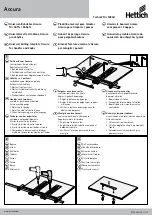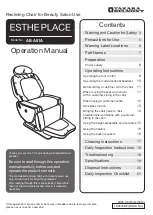
- 9 -
AC Voltmeter
Camera
Monitor
Bridge Tap
NV-213
A
NV-213
A
NVT TROUBLESHOOTING
If you are experiencing problems, attempt to simplify your setup. Test
each cable segment separately. For example, test the camera and
monitor together without the other equipment. Then add in the NVT
transceivers, back-to-back. Test each segment of a long cable-run
independently. Attempt to isolate the problem.
Below are problems that may be encountered. If the suggestions below
are not helpful, or the recommendations are not effective, please call
NVT’s customer support. NVT customer support can be reached 8:00
AM to 5:30 PM PST at (800) 959-9870 or at (+1) (650) 562-0600.
FAINT OR BLURRY PICTURE; LITTLE OR NO COLOR
Possible causes include:
1. Shielded twisted-pair cable. Verify that the wire is unshielded
twisted-pair cable. Multi-pair cable with an overall shield is OK.
2. Longer wire distance than expected. Be sure to include any coax
cable that’s part of this distance. Verify end-to-end connectivity
with an ohm meter. Measure the distance by disconnecting the
transceivers, shorting the far end, reading the loop’s resistance
at the near end. See above for ohm vs. distance ratings. If
necessary, replace transceivers with correct models specified for
this distance.
3. Incorrect distance equalization setting. Adjust the equalization
controls) with a mini screwdriver (NV-652R, NV-862R or the NV-
1662R). If the transmitter is an NV-653T, verify correct equalization
switch setting.
4. Poor connection at a punch-block, splice, or coax cable. Re-check
using the method described in #2 above, or use a wire test set.
5. Short between conductors of the twisted-pair. Use an ohm meter to
locate the short.
6. Transient protection devices employing metal-oxide varistors. Use
carbon blocks, gas-discharge tubes, or NVT transceivers w
i
th built-
in protection.
7. Check the camera. Are the focus and iris set correctly? Verify with
portable monitor.
EXTREMELY FAINT PICTURE
Only faint shadows of the original picture are visible. One of the
twisted pair conductors is open or the wires are shorted together.
Check with an ohm meter.
OVER-SATURATED COLORS; HIGH CONTRAST GRAINY
PICTURE; TOO BRIGHT, TORN PICTURE
Adjust the distance equalization as necessary. Verify that the monitor
has a 75 termination, not in “loop-through”.
WON'T SYNC; WIDE, WHITE JAGGED AREAS
Looks like a scrambled Cable TV signal. Check polarity.
WON'T SYNC; TORN PICTURE
1. Make sure that you are using unshielded twisted pair wire.
2. Check distance equalization settings.
3. For installations with passive (non-amplified) transceivers at both
ends, check for ground loops. This may be done with an AC
Voltmeter, as shown below:
If the voltage is greater than 1/2 volt, use an amplified receiver,
such as the NV-652R, NV-862R, or NV-1662R.
Alternately, remove the ground at one end (usually at the camera
end). Be sure that floating the camera conforms to local/regional
and National Electrical Codes.
4. Check for crosstalk from a second video path. Disconnect all other
video sources. If the problem goes away, check for a split-pair or
un-twisted wire.
FAINT STRIPES GLIDING UP OR DOWN THE SCREEN
These are caused by crosstalk from a second video path, or with
ground-loops in installations employing passive models at both ends.
1. To identify, disconnect all other video signals temporarily. If the
interference goes away, check the wire to make sure the signal is
traveling through a twisted pair. Is two-way video being sent more
than 1,000 ft (300m) over Category 2 or 3 wire? If so, the send
and receive signals may need to go in separate jacketed cables, or
upgrade to Category 5 wire.
2. Next, check for ground loops. See #3 above.
NO POWER LIGHT ON THE NVT UNIT
Check the blue “power” LED on powered NVT units. If the light is not
on, the receiver is not getting power. Re-check the power source and
connections.
If the green LED is on but the power LED is off, check that the power
supply is floating. Grounding one side of the power input may cause
this condition.
NO GREEN LIGHT, NO VIDEO
The NV-652R, NV-862R or NV-1662R series receiver/hub is not
detecting a video signal. There is an open or shorted connection.
Use a multimeter to locate the fault.
GHOSTS
Faint shadows of the original signal shifted to the right. This is
caused by an impedance mismatch along the wire. Verify that the
monitor is terminated with 75 (not in “loop-through”.) Check that all
wire is
unshielded
twisted pair. The high-frequency wire impedance
should be 100. Check for bridge-taps (see below) either by inspecting
wiring closet connections, or, if available, using a “Time-Domain
Reflectometer” (T.D.R.), sometimes called a “cable tester”.
If the faint shadows are not copies of the original picture, but from the
picture of some other camera, check for crosstalk:
Is any portion of the wire un-twisted?
Are the signals from two cameras split between two pairs?
Is there a short between a conductor of one signal and a conductor
of another?



























